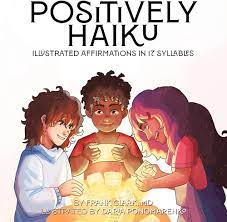Positively Haiku: Illustrated Affirmations in 17 Syllables
This book offers positivity via a unique form of poetry.
Positively Haiku by Frank C. Clark, MD; Illustrated by Daria Ponomarenko

BOOK REVIEW
Positively Haiku: Illustrated Affirmations in 17 Syllables
by Frank C. Clark, MD; Illustrated by Daria Ponomarenko
Argyle Fox Publishing, 2023; 36 pages
Reviewed by Richard M. Berlin, MD
In the 17th century, haiku poems evolved from a much longer Japanese poem form known as renga. A renga’s opening verse contains 3 unrhymed lines of 5, 7, and 5 syllables, and poets like Matsuo Basho (1644-1694) began to use these first 3 lines as a template for composing small standalone poems, a form that eventually became known as haiku. Here is a famous example by Basho (note: the syllable count is lost in translation from the Japanese):
In Kyoto,
hearing the cuckoo,
I long for Kyoto.
And 100 years later, a humorous haiku from Kobayasha Issa (1763-1828):
Don’t worry, spiders,
I keep house
casually.
By the early 20th century, haiku began to gain mainstream recognition outside of Japan. In the English-speaking world, the form was popularized by Imagist poets like Ezra Pound (1885-1972) who wrote poetry to create images with simple language and a sharp focus. Here is a Pound haiku about a woman who has been rejected by her lover:
O fan of white silk
Clear as frost on the grass-blade
You are also laid aside
Later in the 20th century, poets like Jack Kerouac (1922-1969) continued to develop the haiku form. Kerouac called his haiku “pops” and said:
“I don’t think American Haikus…should worry about syllables because American speech is something again…bursting to pop. Above all, a Haiku must be very simple and free of all poetic trickery and make a little picture and yet be as airy and graceful as a Vivaldi Pastorella.”
Here is a Kerouac pop:
In the sun
The butterfly wings
Like a church window
By the time of the coronavirus pandemic, haiku had a worldwide reach. Consider “Social Distancing, Haiku, and You!” a digital sound collage created by Alan Nakagawa for the Orange County Museum of Art. Nakagawa asked participants from around the world to write and digitally record haikus inspired by their own personal experiences during the pandemic. Nakagawa subsequently created a sound collage that interweaves 500 haiku recited by their authors into a single composition.
Another novel use of haiku has been taking place at our medical school, where haiku has become one of the formats used for reflective writing, with students writing haiku poems to express the essence of their interactions with patients.
In the world of medical publishing, the online journal Pulse publishes haiku as a regular feature. There are scores of haiku literary journals, interest groups, and poets who express themselves with this poetic form.
Joining this magnificent stream of more than 500 years of haiku poetry, psychiatrist-poet Frank C. Clark, MD, has created a brilliant new way to use haiku in his book Positively Haiku: Illustrated Affirmations in 17 Syllables. Here are 2 positive affirmations:
Today, I’m enough.
Tonight, I will rest with peace.
Tomorrow, I rise.
I am beautiful.
I am smart and insightful.
I am the future.
Each of the book’s 20 positive affirmation haiku is illustrated by Daria Ponomarenko with exuberant, colorful images of children and adolescents engaged in a variety of activities: climbing a mountain, standing beneath a blossomed cherry tree, singing in a forest to a group of birds. Of note is that the illustrated youth represent a diverse array of ages and ethnicities. In addition, by following a QR code at the beginning of the book, the reader can access the delightful musical score composed by Nan Avant, designed to accompany the experience of reading the positively haiku affirmations.
Although the affirmations will be appreciated through quiet reading by an individual child or adolescent, I suspect they will have additional impact when read in collaboration with a peer group, parent, or teacher who can encourage the youth to consider how each affirmation applies to their own unique life. Since the haiku form is so simple and elegant, I can also imagine parents and teachers using this form to encourage youth to create positive affirmations for themselves, their families, and their peers. As Dr Clark reminds us in his inspiring final haiku, illustrated with a child standing with a pet dog on a pier, gazing at the sun rising over the sea:
Plans are not static.
My journey has just begun.
Time will write my tale.
Dr Berlin has been writing a poem about his experience of being a doctor every month for the past 25 years in Psychiatric Times® in a column called “Poetry of the Times.” He is instructor in psychiatry, University of Massachusetts Medical School, Worcester, Massachusetts. His latest book is Freud on My Couch.
